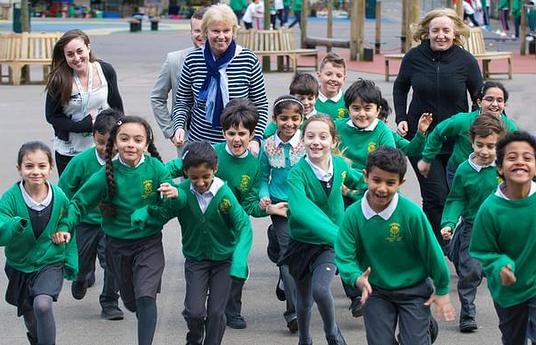If you live in the northern hemisphere, you’re probably eagerly awaiting the first signs of spring and the chance to frolic in the sunshine. We certainly are. Being cooped up all winter is no fun.
Yet for kids growing up today this sedentary, indoor, and isolated lifestyle is the norm all year round. Exploring nature used to go hand in hand with being a child but now children spend the vast majority of their time indoors. either at home or in the classroom. Getting outside has huge implications for child health, wellbeing, learning and development, so immersing kids in nature couldn't be more critical.
It's not exactly surprising that getting outside can improve children’s health. Childhood obesity, asthma, myopia and general lack of fitness have all been attributed – at least in part – to a radical reduction in time spent outside. Rickets, a Victorian-era disease associated with lack of vitamin D, is even making an unwelcome comeback in wealthy countries like the UK. Could part of the answer lie just beyond the classroom door? After all, healthy immunity-boosting microbes, vitamin D and plentiful exercise opportunities can all be found in the great outdoors.
Nature can also be a boon to mental wellbeing. Some scientists believe that humans have an innate love for nature and a tendency to seek connections with living things – a theory called ‘biophilia’. This seems to make sense when you consider how vital nature is for human health and wellbeing.
Eco-therapy is gaining in popularity and shinrin-yoku (the Japanese practice of forest bathing) is lauded for its stress-busting benefits. So it's no surprise that breaking free from the classroom and diving into nature boosts children’s mental health. Just five minutes of exercise in a green space has been found to improve mood and also raise self-esteem, particularly for young people, and particularly if water, such as a river or pond, is also present.
"Kids get to experience the changing of the seasons, feel the sun, wind and rain on their skin - blissful experiences that can't be replaced by even the best VR"
This might all seem very compelling. But how can schools strapped for time and resources help children to get outside more? One simple way is to practice The Daily Mile, where students break free of the classroom to run, jog or walk for 15 minutes each day. No resources required, other than a safe outdoor space. The Daily Mile benefits mental and physical health, as well as boosting concentration back in class – making it an all-around worthwhile investment.
Whether it’s laps of the school yard or the local park, every student can experience the exhilaration of running wild and free in the fresh air. As well as a good workout, kids get to experience the changing of the seasons, feel the sun, wind and rain on their skin – blissful experiences that can't be replaced by even the best VR.
You only have to look back to your own childhood to see that your most vivid learning memories probably weren’t from a textbook, but from some kind of hands-on activity. Pond dipping, butterfly catching, and tree climbing formed the childhood of many of today's adults, but the same isn’t true for this generation of youngsters. In a world where technology is ubiquitous and there exists a growing chasm between kids and their natural environment, outdoor learning can give kids a much-needed dose of nature.
Outdoor learning is gaining in popularity and it’s easy to see why. There’s evidence that increased contact with nature can improve the way children learn, so it’s worth setting aside time to get outside. Learning outdoors can give practical, direct experiences of a given subject and thereby deepen understanding.
One inspiring example is The Outdoor Discovery Center in Singapore, which gifts every child with the cognitive, social and physical benefits of daily outdoor learning. The center is made up of 15 outdoor classrooms, converted from a playing field and built from all natural materials. Outdoor learning classrooms are used for a whole host of lessons, including science and creative arts as well as growing vegetables and most importantly - playing!
Echoing research on how exposure to nature can affect kids, the school reports increased attention, curiosity, and concentration after the outdoor sessions, as well as a boost in positive behavior. Getting outdoors also seems to increase the learners' imagination and creative problem-solving skills, while parents are pleased with their children's enthusiasm for school as well as improved sleep.
Principal JoAn Radojkovich explains that outdoor learning makes perfect sense, saying; “If we want healthy, functioning children who understand the value and importance of the outdoor environment, we need to create opportunities for them to experience it every day. Being outdoors provides ample opportunities to practice assessing risk, problem-solving, teamwork and dealing with failure."
Assessing risk and problem-solving are vital skills for life. But modern childhood doesn't provide too many opportunities to develop these. Unlike generations before them, children today are more likely to get hurt falling out of bed than out of a tree branch. And while nobody is advocating the breaking of bones, this shocking statistic speaks to how kids are being denied the opportunity for exploration and adventure outside.
This is important. As nature is so unpredictable, being outdoors provides ample opportunities to practice assessing risk, problem-solving, teamwork and dealing with failure - all skills that come in handy throughout school and later life. Adults worry about child safety, but protecting them from every possible risk doesn't protect them in the long run, as careful exposure to certain risks can help them learn how to deal with risk safely.
If getting kids up trees is a good thing, getting them into a whole forest may be just what the doctor ordered! One popular way of learning immersed in nature is Forest School, a concept which originated in Scandinavia and is now a growing movement throughout the world.
Forest School is a long-term, child-centered approach to outdoor learning. It offers all learners opportunities for holistic development through regular, hands-on experiences in a woodland style natural environment. The case for Forest School is not hard to make.
Green surroundings can improve children’s cognitive functioning, attention, mood and cortisol levels, so outdoor learning can benefit any child. But approaches like Forest School can be particularly beneficial to children with special needs. For example, exposure to nature has been found to reduce symptoms of ADHD in children threefold compared with staying indoors. In fact, the greener a child’s play area, the better her attentional functioning (and what’s more green than a forest!?)
A typical Forest school day means plenty of physical exploration of the natural environment. In the minds of imaginative kids, trees magically become climbing frames and sticks become swords or paint brushes, while pine cones and leaves are handy props for arts and drama. The forest also provides bountiful opportunities to experience risk and challenge, to problem solve and enterprise, all at the child’s own pace. Quite the opposite of languishing in front of a screen or a whiteboard, the students are curious, active and engaged.
A testament to this is seven-year-old Luke, a student of Longworth Forest in New Zealand. Luke brims with enthusiasm about learning in the woods, saying; “The Forest is my life. For me, solving problems in the Forest is just what I do. I like solving problems. You're always outside, you've got to get your legs moving. Instead of sitting down reading about it, you're actually doing it.”
Unfortunately, sitting down and reading about it is exactly what many kids are doing. Many students will learn a pistil from a stamen without ever having the chance to see or smell a flower up close. Whatsmore, it’s unusual for a traditional classroom to contain even a hint of the natural world outside – aside from wooden desks, that is.
Nature is also being erased from childhood experience in less obvious ways, for example, children’s dictionaries being stripped of natural words in favor of technological lingo, showing we’ve collectively decided that nature is no longer significant for youngsters. It’s true that kids are distant from the natural world. In the US children under eight are spending more than two hours daily staring at screens, whilst three-quarters of UK children spend less time outdoors than prison inmates. But what if they never had to leave their classrooms to get a dose of nature?
Just having plants in the classroom could benefit student psychology and behavior. And while a potted orchid or daffodil might work wonders jazzing up your classroom, have you ever considered growing more than that? The Green Bronx Machine shows that plants and pupils make the perfect match. Students grow their own fresh food, learn to prepare it and take it home to their families.
This is nothing short of a green revolution in the South Bronx, which has been described as a ‘food desert’ due to a dearth of fresh fruits and vegetables available in stores. Children here are now learning where a carrot comes from and what it tastes like. They are also learning the taste of success; growing vegetables in school has led to higher graduation rates and opportunities for career-related skill development. Health has shot up and so too has learning and school performance, with attendance growing from 40% to a staggering 93%!
"Bringing nature inside in this way is both novel and inclusive, as children with disabilities who might find it hard to work in a garden can get their hands dirty too"
While getting outside has major benefits, the magic of this approach is that anyone can get involved without stepping foot into a garden. As well as gardening in outdoor spaces, Green Bronx Machine also use vertical planters in classrooms and create edible walls in corridors. Bringing nature inside in this way is both novel and inclusive, as children with disabilities who might find it hard to work in a garden can get their hands dirty too.
Green Bronx Machine grows enough food in the classroom to feed a whole school all year long. It is a living, breathing classroom where plants and food are everywhere. The success of Green Bronx Machine indicates that growing food is a nourishing experience both physically and mentally; that goes for the students and the wider community, as Ritz says, “We grow vegetables. Our vegetables grow students, schools, communities, and opportunities.”
Fostering a sense of global community is vital going forward. In times of environmental degradation and mass extinction, it couldn’t be more critical to forge an understanding of and deep connection to the rest of the natural world.
Afterall, we protect what we love. A sense of our place in the vastness nature can also help us to develop a worldview of collective identity with the humans we share this planet with. Take Universe Awareness, for instance, who use the beauty and scale of the universe to foster a sense of global empathy and connection. Children are introduced to the planet through the Earth Ball, which shows the earth from space without any geopolitical borders and boundaries. Using this, teachers can ensure that the first things children learn about the planet are not political divides and national borders, but day and night, seasons, biology and geography - the earth in all its natural splendor.
"As well as boosting engagement once in the classroom, being 'free range' can have other life long benefits"
In the same way that geopolitical borders can change over time, so too do the borders erected around children by well-meaning parents and teachers. In a single generation, the area children are allowed to roam unsupervised outside the home has decreased by almost 90%. If you, like two-thirds of UK parents, believe that children have less freedom to roam than free-range chickens, consider implementing Free Range Kids, an easy to adopt class-based program that encourages children to walk to school, with an emphasis on adventure!
As well as boosting engagement once in the classroom, being 'free range' can have other life-long benefits such as developing self-confidence, resilience and risk management. Kids journal about their adventures on the journey to school and this provides the class with fresh stimuli for learning - for example; they may spot an unusual looking bird, or be shocked at the amount of litter along their route. The natural environment provides endless opportunity for learning and discussion!
Whether it’s bringing nature to the children or bringing the children to nature, there are myriad ways educators can change the narrative of cooped up kids. Nature is filled with symbiotic relationships and this is just one more example, nature and the future generation are dependent on each other. If we allow children to experience childhood fully, grubby fingernails, scratched knees and all - we allow them to opportunities for the kind of holistic growth that will benefit them, their community and the environment they will be charged with protecting. Don’t wait another moment to get your class outside!


